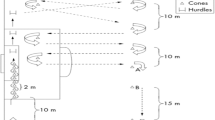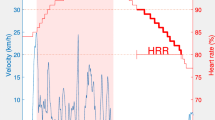Abstract
Athletes in prepubescent require a specialized approach to training process and its control, taking into consideration a broad range of physiological and training aspects in adolescents. The objective of the study was to evaluate fitness level of young soccer players and the search for interrelations between parameters of laboratory and field tests with the physiologic measurements during match play. The proposed paper provides coaches, sports scientists and physicians with important information on sufficient fitness control based on accessible and reliable tests. Twenty six healthy male soccer players born in 2004 aged 12–13 underwent the following laboratory testing: cycling stress-test with gas-exchange measurements, Wingate cycling test, performance analysis for vertical jumps and blood lactate measurements. Field tests included maximal interval running field test and jumping tests, as well as soccer game analysis with heart rate monitoring. Obtained data described overall parameters of young soccer players aged 12–13 from laboratory, field tests and game analysis with further comprehensive detailed interpretation. Significant interrelations between indicators of fitness condition, obtained from laboratory and field tests were found. For successful training management in young soccer players, laboratory and field tests should be widely used.
Access this chapter
Tax calculation will be finalised at checkout
Purchases are for personal use only
Similar content being viewed by others
References
ACC/AHA 2002 guideline update for exercise testing: summary article: a report of the American College of Cardiology/American Heart Association Task Force on practice guidelines. J. Am. Coll. Cardiol. 48, 1731 (2006)
Aquino, R.L., et al.: Biochemical, physical and tactical analysis of a simulated game in young soccer players. J. Sports Med. Phys. Fitness 56, 1554–1561 (2016)
Barbero-Álvarez, J.C., Pedro, R.E., Nakamura, F.Y.: Validity of a repeated-sprint ability test in young soccer players. Sci. Sports 28(5), 127–131 (2013)
Buchheit, M., Delhomel, G., Ahmaidi, S.: Time-motion analysis of elite young French soccer players. Coach. Sport Sci. J. 3, 21 (2008)
Buchheit, M., Mendez-Villanueva, A., Simpson, B.M., Bourdon, P.C.: Match running performance and fitness in youth soccer. Int. J. Sports Med. 31, 818–825 (2010)
Cambell, P., et al.: Prediction of physical activity and physical work capacity (PWC 170) in young adulthood from childhood and adolescence with consideration of parental measures. Am. J. Hum. Biol. 13, 190–196 (2001)
Castagna, C., D’ottavio, S., Abt, G.: Activity profile of young soccer players during actual match play. J. Strength Cond. Res. 17, 775–780 (2003)
Castagna, C., Impellizzeri, F., Cecchini, E., Rampinini, E., Alvarez, J.C.B.: Effects of intermittent-endurance fitness on match performance in young male soccer players. J. Strength Cond. Res. 23, 1954–1959 (2009)
Chtourou, H., Hammouda, O., Souissi, H., Chamari, K., Chaouachi, A., Souissi, N.: Diurnal variations in physical performances related to football in young soccer players. Asian J. Sport. Med. 3(3), 139–144 (2012)
Cunha, G., Lorenzi, T., Sapata, K., Lopes, A.L., Gaya, A.C., Oliveira, Á.: Effect of biological maturation on maximal oxygen uptake and ventilatory thresholds in soccer players: an allometric approach. J. Sports Sci. 29, 1029–1039 (2011)
Foster, C., Hector, L.L., Welsh, R., SchrageR, M., Green, M.A., Snyder, A.C.: Effects of specific versus cross-training on running performance. Eur. J. Appl. Physiol. 70, 367–372 (1995)
Foster, C., et al.: A new approach to monitoring exercise testing. J. Strength Cond. Res. 15, 109–115 (2001)
Goodwinn, M.L., et al.: Blood lactate measurements and analysis during exercise: a guide for clinicians. J. Diab. Sci. Technol. 1, 558–569 (2007)
Impellizzeri, F.M.: Use of RPE-based training load in soccer. Med. Sci. Sports Exerc. 36, 1042–1047 (2004)
Jastrzębski, Z., Barnat, W., Konieczna, A., Rompa, P., Radzimiński, Ł.: Changes of physical capacity and soccer-related skills in young soccer players within a one-year training period. Balt. J. Health Phys. Act. 3(4), 248–261 (2011)
Joo, C.H., Seo, D.I.: Analysis of physical fitness and technical skills of youth soccer players according to playing position. J. Exerc. Rehabil. 12, 548–552 (2016)
Júnior, J.B.S., da Silva Carvalho, R.G., Ferreira, J.C., da Silva, N.W.P., Szmuchrowski, L.A.: Correlação entre os índices do teste de corrida com o teste de Wingate. Arquivos em Movimento 4(1), 12–22 (2010)
Lara, A., Abián, J., Alegre, L.M., Jiménez, L., Aguado, X.: Jump tests on a force platform for applicants to a sports science degree. J. Hum. Mov. Stud. 50(2), 133–147 (2006)
Krustrup, P., Mohr, M., Ellingsgaard, H.E.L.G.A., Bangsbo, J.: Physical demands during an elite female soccer game: importance of training status. Med. Sci. Sports Exerc. 37, 1242 (2005)
Mohr, M., Krustrup, P., Bangsbo, J.: Match performance of high-standard soccer players with special reference to development of fatigue. J. Sports Sci. 21, 519–528 (2003)
Ntai, A., Zahou, F., Paradisis, G., Smirniotou, A., Tsolakis, C.: Anthropometric parameters and leg power performance in fencing. Age, sex and discipline related differences. Sci. Sports 32(3), 135–143 (2017)
Tabata, I., et al.: Effects of moderate-intensity endurance and high-intensity intermittent training on anaerobic capacity and VO2max. Med. Sci. Sports Exerc. 28, 1327–1330 (1996)
Tarbeeva, N.: Method of Tabata interval training as a way of speed strength endurance control in cross country skiing. J. Uchenye zapiski universiteta imeni P.F. Lesgafta 76(6), 156–159 (2011)
Ortega, F.B., et al.: Physical fitness levels among European adolescents: the HELENA study. Br. J. Sports Med. 45(1), 20–29 (2011)
Shishkina, A.V.: Special power preparation of the qualified skiers-racers. J. Uchenye zapiski universiteta imeni P.F. Lesgafta, 3(25), 99–103 (2007)
The International Football Association Board: Laws of the Game. FIFA, Zurich (2016)
Van Hooren, B., Zolotarjova, J.: The difference between countermovement and squat jump performances: a review of underlying mechanisms with practical applications. J. Strength Cond. Res. 31(7), 2011–2020 (2017)
Vilikus, Z.: Functional Diagnostics, pp. 12–15. College of Physical Education and Sport, Palestra (2012)
Yanci, J., Los Arcos, A., Mendiguchia, J., Brughelli, M.: Relationships between sprinting, agility, one-and two-leg vertical and horizontal jump in soccer players. Kineziologija 46(2), 194–201 (2014)
Zakharova, A., Berdnikova, A., Tarbeeva, A., Matvienko, V.: High intensity interval testing for fitness control of young football players. J. Uchenye zapiski universiteta imeni P.F. Lesgafta 124(6), 70–75 (2015)
Zakharova, A.V., Berdnikova, A.N.: Monitoring of power abilities in young football players. Hum. Sports Med. 16(4), 64–74 (2016)
Zakharova A., Mekhdieva K., Berdnikova A.: Comprehensive fitness control in young soccer players - comparison of laboratory and field testing indicators. In: icSPORTS 2017: Proceedings of the 5th International Congress on Sport Sciences Research and Technology Support Support, pp. 25–32 (2017)
Acknowledgements
The work was supported by Act 211 Government of the Russian Federation, contract # 02.A03.21.0006.
Author information
Authors and Affiliations
Corresponding author
Editor information
Editors and Affiliations
Rights and permissions
Copyright information
© 2019 Springer Nature Switzerland AG
About this paper
Cite this paper
Zakharova, A., Mekhdieva, K., Berdnikova, A. (2019). Laboratory and Exercise Fitness Control in Young Soccer Players. In: Cabri, J., Pezarat-Correia, P., Vilas-Boas, J. (eds) Sport Science Research and Technology Support. icSPORTS icSPORTS 2016 2017. Communications in Computer and Information Science, vol 975. Springer, Cham. https://doi.org/10.1007/978-3-030-14526-2_12
Download citation
DOI: https://doi.org/10.1007/978-3-030-14526-2_12
Published:
Publisher Name: Springer, Cham
Print ISBN: 978-3-030-14525-5
Online ISBN: 978-3-030-14526-2
eBook Packages: Computer ScienceComputer Science (R0)




